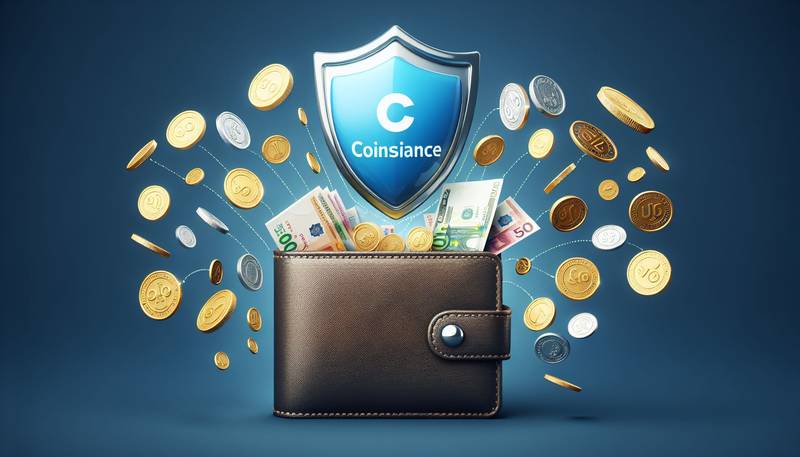Peer-to-Peer Insurance: A New Model for Sharing Risk
Peer-to-peer insurance is a disruptive innovation in the insurance industry that is quickly gaining popularity as a new model for sharing risk among individuals. Unlike traditional insurance companies, peer-to-peer insurance platforms connect policyholders directly, allowing them to pool their resources and share risks collectively.
- 1/3/2024
- 3 min read
 Click
to read the article
Click
to read the article
This approach not only promotes transparency and trust among members but also reduces costs and administrative overhead typically associated with traditional insurance providers.
The Rise of Peer-to-Peer Insurance
The concept of peer-to-peer insurance is not entirely new, but it has gained significant traction in recent years due to advances in technology and changing consumer attitudes towards traditional insurance companies. As people become more wary of large corporations and seek more personalized, community-based solutions, peer-to-peer insurance offers a viable alternative that puts policyholders in control of their coverage.
How Peer-to-Peer Insurance Works
In a peer-to-peer insurance model, policyholders come together to form a community or network on a digital platform. Each member contributes a predetermined amount into a shared pool to cover potential claims within the group. When a member experiences a covered loss, they submit a claim to the community, and fellow members vote on the validity of the claim. If approved, funds from the shared pool are used to compensate the member for their loss.
Benefits of Peer-to-Peer Insurance
One of the key benefits of peer-to-peer insurance is the potential for lower premiums and higher payouts for policyholders. By eliminating the need for intermediaries and streamlining administrative processes, peer-to-peer insurance platforms can significantly reduce operating costs, allowing for more competitive pricing and better coverage for members. Additionally, the transparency and trust that come with peer-to-peer insurance create a sense of community and shared responsibility among policyholders.
Challenges and Considerations
While peer-to-peer insurance offers many advantages, it is not without its challenges. One of the main concerns is the potential for moral hazard and adverse selection within the community. Without proper controls and oversight, some members may be tempted to submit fraudulent claims or take advantage of the system. To mitigate these risks, peer-to-peer insurance platforms often employ strict vetting processes, risk assessments, and community monitoring to ensure the integrity of the network.
The Future of Peer-to-Peer Insurance
As peer-to-peer insurance continues to grow in popularity, more traditional insurance companies are taking notice and exploring similar models to stay competitive. With advancements in technology such as blockchain and artificial intelligence, peer-to-peer insurance platforms are becoming more sophisticated and scalable, offering innovative solutions to the age-old problem of risk management. In the coming years, we can expect to see more collaboration between traditional insurers and peer-to-peer platforms, leading to a more diverse and consumer-centric insurance market.
The growth of the peer-to-peer insurance market is also being driven by shifting consumer expectations and demands for more personalized and flexible insurance solutions. As individuals seek greater control over their coverage and costs, peer-to-peer insurance platforms are well-positioned to meet these needs by offering tailored policies and customizable coverage options. This level of customization not only enhances the overall customer experience but also fosters a sense of empowerment and ownership among policyholders.
Another significant advantage of peer-to-peer insurance is the potential for increased transparency and accountability within the industry. By moving away from centralized decision-making and involving policyholders in the claims process, peer-to-peer insurance platforms create a more democratic and participatory environment where members have a direct stake in the success and sustainability of the community. This collaborative approach not only builds trust among members but also helps to weed out unethical behavior and fraud, ultimately benefiting the entire network.
Moreover, the peer-to-peer insurance model promotes a shared sense of responsibility and solidarity among policyholders, shifting the focus from individual risk management to collective risk-sharing. By working together to protect each other against unforeseen events and losses, members of a peer-to-peer insurance community establish a bond based on mutual support and shared goals. This shared commitment to the well-being of the group can lead to lower transaction costs, faster claims processing, and a more efficient allocation of resources, ultimately benefiting all members of the community.
However, despite its many advantages, peer-to-peer insurance still faces several challenges that must be addressed to ensure its long-term success. One of the main challenges is achieving a balance between protecting the interests of policyholders and maintaining the financial stability of the community. Since peer-to-peer insurance operates on a cooperative basis, the actions of individual members can have a significant impact on the overall risk pool and financial health of the network. To address this challenge, peer-to-peer insurance platforms must implement robust risk management strategies, financial reserves, and contingency plans to safeguard against unexpected losses and maintain the sustainability of the community.
Additionally, peer-to-peer insurance platforms must continuously adapt to changing market dynamics, regulatory requirements, and technological advancements to remain competitive and relevant in the insurance industry. With increasing competition and evolving customer preferences, peer-to-peer insurance providers must innovate and differentiate themselves to attract and retain policyholders. This may involve expanding their product offerings, enhancing their digital capabilities, and forging strategic partnerships with other industry players to create a more comprehensive and integrated insurance ecosystem.
Looking ahead, the future of peer-to-peer insurance is promising, with potential for continued growth and evolution as consumers seek more flexible and community-driven insurance solutions. By harnessing the power of technology, collaboration, and shared values, peer-to-peer insurance platforms have the opportunity to revolutionize the insurance landscape, empower policyholders, and build resilient and sustainable communities of mutual support and protection. As the industry continues to evolve and adapt to changing market forces, peer-to-peer insurance is poised to play a significant role in shaping the future of insurance and redefining how risks are shared and managed in a rapidly changing world.
Recent posts
Random news

The Evolution of the Insurance Industry: A Historical Perspective
- 2024-03-01T00:00:00Z

Understanding Premiums, Deductibles, and Coverage Limits
- 2024-01-15T00:00:00Z

The Role of Underwriting in Insurance
- 2023-12-27T00:00:00Z

Exploring the Different Types of Liability Insurance
- 2023-12-11T00:00:00Z

The Benefits and Limitations of Whole Life Insurance
- 2024-03-06T00:00:00Z

An Introduction to Commercial Insurance for Business Owners
- 2024-02-02T00:00:00Z

Travel Insurance: Why It's Essential for Your Next Trip
- 2024-01-18T00:00:00Z

Renters Insurance: An Often Overlooked Necessity
- 2023-12-11T00:00:00Z

Pet Insurance: Is It Worth the Cost?
- 2023-12-30T00:00:00Z

Auto Insurance Essentials: What Every Driver Needs to Know
- 2023-12-14T00:00:00Z

Tips for Lowering Your Insurance Premiums
- 2023-12-30T00:00:00Z

Cyber Insurance: Protecting Businesses in the Digital Age
- 2024-02-04T00:00:00Z

The Importance of Disability Insurance in a Financial Plan
- 2024-01-27T00:00:00Z

Insurance and Natural Disasters: How to Protect Your Home
- 2023-12-19T00:00:00Z

The Impact of Technology on the Insurance Sector
- 2024-01-15T00:00:00Z

Critical Illness Insurance: What It Covers and Why It's Important
- 2023-12-29T00:00:00Z

Insurance Fraud: Detection, Prevention, and Consequences
- 2024-02-24T00:00:00Z

The Psychology Behind Insurance: Trust, Risk, and Decision Making
- 2023-12-30T00:00:00Z

The Global Insurance Market: Trends and Growth Opportunities
- 2023-12-14T00:00:00Z

The Intersection of Artificial Intelligence and the Insurance Industry
- 2024-02-12T00:00:00Z

Life Insurance: Securing Your Family's Future
- 2024-02-20T00:00:00Z

How Climate Change is Shaping the Insurance Industry
- 2024-03-08T00:00:00Z

Group Insurance Plans: Benefits for Employers and Employees
- 2024-02-09T00:00:00Z

Reinsurance Explained: How It Works in the Insurance Industry
- 2024-02-03T00:00:00Z

Environmental Liability Insurance: What Businesses Need to Know
- 2024-02-17T00:00:00Z

The Future of Insurance: Predictions and Innovations
- 2024-01-04T00:00:00Z

Insurance for Freelancers: Protecting Your Independent Career
- 2024-03-03T00:00:00Z

Annuities: Combining Insurance and Investment for Retirement
- 2024-03-17T00:00:00Z

Marine Insurance: Covering the Risks of Sea Transport
- 2024-01-28T00:00:00Z

Flood Insurance: Understanding Your Coverage Options
- 2024-02-03T00:00:00Z

The Role of Agents and Brokers in the Insurance Industry
- 2023-12-11T00:00:00Z

How Insurance Supports Economic Growth and Stability
- 2023-12-25T00:00:00Z

Vision Insurance: Seeing the Benefits Clearly
- 2024-02-22T00:00:00Z

Insurance Against Identity Theft: What You Need to Know
- 2024-02-07T00:00:00Z

The Rise of Telemedicine and Its Impact on Health Insurance
- 2024-03-17T00:00:00Z

Insurance in the Sharing Economy: Challenges and Solutions
- 2024-01-15T00:00:00Z

Digital Platforms Transforming the Insurance Buying Experience
- 2024-03-10T00:00:00Z

The Intersection of Blockchain Technology and the Insurance Industry
- 2024-03-07T00:00:00Z

Understanding the Insurance Policy Lifecycle
- 2023-12-14T00:00:00Z

Understanding the Fine Print: Insurance Policy Exclusions
- 2024-02-11T00:00:00Z

Making Sense of Health Savings Accounts (HSAs) and Insurance
- 2024-03-12T00:00:00Z

Insurance and Public Health: A Complex Relationship
- 2023-12-27T00:00:00Z

Long-Term Care Insurance: Planning for the Future
- 2024-02-23T00:00:00Z

Insurance Literacy: Understanding Your Rights and Responsibilities
- 2024-02-10T00:00:00Z

Insurance for Young Adults: What You Need to Know
- 2024-01-04T00:00:00Z

The Changing Landscape of Life Insurance: Trends to Watch
- 2024-03-02T00:00:00Z

Insurance Claims: A Step-by-Step Guide to Filing and Settlement
- 2024-02-21T00:00:00Z

The Economics of Insurance: How Markets Operate
- 2024-02-21T00:00:00Z

Bridging the Gap: Insurance and Social Justice
- 2024-03-08T00:00:00Z

The Ins and Outs of Motorcycle Insurance
- 2023-12-17T00:00:00Z

The Legal Landscape of Insurance: Key Regulations and Challenges
- 2024-01-28T00:00:00Z

Directors and Officers Insurance: Safeguarding Corporate Leaders
- 2023-12-25T00:00:00Z

A Guide to Managing Insurance Costs in Small Businesses
- 2024-02-27T00:00:00Z

Insurance and Retirement Planning: A Comprehensive Approach
- 2023-12-20T00:00:00Z

Mobile Home Insurance: Coverage and Considerations
- 2023-12-27T00:00:00Z

Disaster Preparedness: The Role of Insurance in Recovery
- 2024-02-25T00:00:00Z

Navigating the Complex World of Health Insurance
- 2024-01-17T00:00:00Z

The Significance of Actuarial Reports in the Insurance Industry
- 2024-02-21T00:00:00Z

How Insurance Policies Are Priced: The Basics of Actuarial Science
- 2024-03-14T00:00:00Z

The Psychology of Insurance: How Coverage Affects Behavior
- 2024-01-01T00:00:00Z

Dental Insurance: Navigating Coverage and Care
- 2024-01-22T00:00:00Z

Umbrella Insurance: Extra Protection Beyond Standard Policies
- 2023-12-31T00:00:00Z

Specialty Insurance: Coverage for Unique Needs and Risks
- 2024-02-09T00:00:00Z

The Challenges and Benefits of High-Deductible Health Plans
- 2024-01-27T00:00:00Z

Understanding Coinsurance: What It Means for Your Wallet
- 2024-03-16T00:00:00Z

Crop Insurance: Supporting Farmers Through Uncertainty
- 2024-01-19T00:00:00Z

Navigating Insurance for Mental Health Services
- 2024-02-09T00:00:00Z

The Role of Insurance in Estate Planning
- 2024-01-23T00:00:00Z

How to Handle Insurance Claims Disputes
- 2024-01-21T00:00:00Z

Condominium Insurance: Understanding Policies and Protection
- 2024-03-09T00:00:00Z

Short-Term Health Insurance: Pros and Cons
- 2024-02-10T00:00:00Z

Understanding the Role of Insurance Adjusters
- 2023-12-25T00:00:00Z

Workers' Compensation: Ensuring Protection for Employees and Employers
- 2024-02-12T00:00:00Z

Healthcare Sharing Ministries vs. Traditional Health Insurance
- 2024-03-19T00:00:00Z

The Future of Autonomous Vehicles and Insurance Implications
- 2024-01-17T00:00:00Z

Gap Insurance: Closing the Coverage Gap in Auto Loans
- 2023-12-16T00:00:00Z

Antique and Collector Car Insurance: A Unique Protection
- 2024-01-13T00:00:00Z

The Impact of Regulatory Compliance on the Insurance Industry
- 2024-02-11T00:00:00Z

Disaster Insurance: Preparing for the Unexpected and Recovering Afterward
- 2024-01-01T00:00:00Z

Navigating the Insurance Marketplace: Strategies for Consumers
- 2024-03-14T00:00:00Z

The Role of Insurance in Disaster Response and Recovery
- 2023-12-12T00:00:00Z

Insurance and Ethics: Navigating Moral Dilemmas in the Industry
- 2023-12-31T00:00:00Z

Maximizing Benefits: Strategies for Effective Insurance Utilization
- 2024-02-05T00:00:00Z


Insurance for Nonprofits: Special Considerations and Needs
- 2024-01-24T00:00:00Z

The Future of Insurance: How Technology is Shaping Coverage and Customer Service
- 2024-02-19T00:00:00Z

Understanding the Fine Print: Key Terms and Conditions in Insurance Policies
- 2024-02-06T00:00:00Z

Life Insurance: Securing Your Family's Future in Uncertain Times
- 2024-02-04T00:00:00Z

Peer-to-Peer Insurance: A New Model for Sharing Risk
- 2024-01-03T00:00:00Z

Navigating the Maze: Choosing the Right Insurance Policy for Your Needs
- 2024-02-26T00:00:00Z

Commercial Insurance: Protecting Your Business from Unseen Risks
- 2024-01-10T00:00:00Z

Insurance and Customer Experience: The Journey to Satisfaction
- 2024-01-24T00:00:00Z

The Evolution of Insurance: From Ancient Times to the Digital Age
- 2024-02-16T00:00:00Z

Insurance Fraud: The Impact on Policyholders and How to Protect Yourself
- 2024-02-13T00:00:00Z

Health Insurance Explained: What You Need to Know to Protect You and Your Family
- 2024-03-06T00:00:00Z

Auto Insurance: Tips for Choosing the Right Coverage and Saving Money
- 2024-01-30T00:00:00Z

Supplemental Insurance: Filling the Gaps in Coverage
- 2024-01-26T00:00:00Z

How to Choose the Right Insurance Policy for Your Needs
- 2024-01-30T00:00:00Z

The Role of Insurance in Mitigating Financial Risk
- 2023-12-06T00:00:00Z

Understanding the Basics of Insurance: A Beginner's Guide
- 2024-03-04T00:00:00Z
 InsurePath: Navigating Your Way to Peace of Mind
InsurePath: Navigating Your Way to Peace of Mind